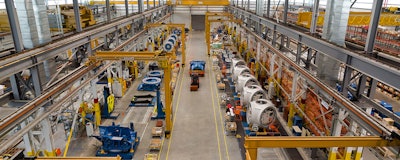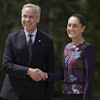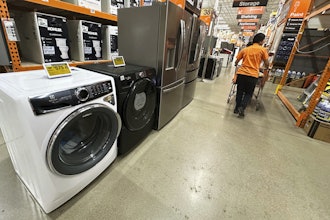
Chicago — The manufacturing sector, globally, is at the center of a period of great change with far reaching implications for businesses across the industrial landscape, according to a research report released by Cushman & Wakefield.
The "manufacturing risk index" is an annual survey of the manufacturing sector, assessing how political, economic, technological and environmental risks are managed during portfolio assessment and site selection by occupiers, including countries outside of the U.S. The report contains an Established Index, which ranks the 30 largest countries by manufacturing output, and a Pioneering Index, which measures the attractiveness on less mature markets where manufacturers are seeking lower operating costs.
Asia Pacific countries continue to dominate the top 10, occupying seven places within the top half of the Established Index, with Malaysia retaining its position as the most attractive market for locating manufacturing facilities. Costa Rica has risen four places on last year to top the Pioneering Index table, as it continues to witness increasing growth through rising levels of foreign direct investment, in both advanced and light manufacturing options.
According to the research report, the North American market will continue to see changing dynamics, as manufacturers and supply chains are impacted by potential trade policy shifts under the new President Trump administration. With the new administration indicating intended reviews of (and taking some early action to impact) both the Trans-Pacific Partnership (TPP), as well as the North American Free Trade Agreement (NAFTA), manufacturers are considering the strategic and tactical changes they may need to consider under multiple "what-if" scenarios. In the first month of 2017, some U.S. auto manufacturers have already announced domestic plant investments and/or geographic shifts in production and plant capacity.
Looking at the market as a whole, the report states that in the short term, manufacturing remains partly constrained by a lack of capital investment in plants, reducing near-term radical shifts in location decisions. However, in the medium term, many questions will be raised about locations that fundamentally service a different era as the sector migrates into what management consultancy McKinsey has called Industry 4.0, which places a greater emphasis on emerging technologies. As a result of the findings from this report Cushman & Wakefield anticipates different criteria becoming more important to future decision making.
John Morris, Head of Logistics & Industrial for the Americas at Cushman & Wakefield: “Even before the 2016 U.S. Presidential Election, we saw shifts in manufacturer and supplier location strategies, as U.S. customers demand faster turnaround times and product customization or value-add options that are often best suited for domestic or North American-based production. With the ongoing changes in maritime shipping alliances, some shipment interruptions in Q4 resulting from the Hanjin bankruptcy, and fluctuating oil prices in 2016, some manufacturers and shippers were reviewing their long-range production strategies to meet customer demands. The North American manufacturing workforce is also experiencing a sea change in demand for higher technical skills required for manufacturing jobs in a technologically (and often highly automated) industry.”
Neil McLocklin, Partner, Strategic Consulting at Cushman & Wakefield: “While macro events such as Brexit and the U.S. Presidential election result carry risks in terms of regulation and market access, disruptive technologies such as additive manufacturing and Robotic Process Automation also continue to transform the manufacturing world by reshaping the production cycle in the longer term.”
“The breadth of the manufacturing sector is expanding beyond the physical production of goods to incorporate research and development, supply chain management, distribution and service provision throughout a product’s lifecycle. Failure to recognize and embrace the advent of such technologies carries significant risk. As such, there is a necessity to get to grips with a ‘new norm’, with more complex, horizontally structured ecosystems of design, technology and service.”
Robert Hall, International Partner, Logistics & Industrial EMEA: “Manufacturers’ decisions on where to locate is being challenged by the need for smarter products, production and supply chain management. This is filtering through into demand for more sophisticated manufacturing space — for which the term ‘shed’ does a disservice.”
Simon O’Reilly, International Partner, Enterprise & Portfolio Solutions EMEA at Cushman & Wakefield: “In a period of accelerating change and digital transformation, pure cost-reduction strategies are being challenged. Companies are increasingly honing in on those activities with the greatest potential for creating value and identifying the talent that will enable them to create it. Therefore, in terms of location, there will likely be a polarization in the production process between innovation, design and development on the one hand locating to high-cost locations, while pure production and assembly remain much more cost sensitive.”
North American Region
The report shows that both the United States of America and Canada secured placements within the top 10. Even prior to Donald Trump’s election victory, there was evidence of a resurgence in manufacturing, in part due to some re-shoring initiatives but also due to a shift in focus to the higher value end of the production process. While the new President is committed to bringing manufacturing jobs back to the U.S., how this will be managed on any significant scale without increasing the costs of production will continue to be a question the industry is asking.
EMEA Region
The impact of Brexit has remained non-threatening for the time being. The prospectus for 2016 was looking relatively subdued with sluggish growth in key European markets, weak commodity prices and emergency market wobbles. However, the market has since been held up by the weakening pound and prospects for 2017 are looking better. While the German market has traditionally been famous for its engineering, a number of central and eastern European countries such as Hungary, Sweden and the Czech Republic remain in the top 10 due to their manufacturing components and ability to provide cheaper alternative assembly options. Location continues to remain significant in this sector, and there is no sign of modern production facilities being relocated or closed purely because of Brexit, but future UK Government decisions could well make a difference.
Asia-Pacific Region
Asia Pacific continues to demonstrate its diversity as a location of choice for manufacturers, occupying almost half of the positions within the top 15 of the Established Manufacturing Index. Given the varying maturing level of technology adoption and priorities across Asia Pacific, each country in the region has a specific focus on areas of innovation to promote sector growth. This includes smart manufacturing in the form of automation in China due to wage inflation, or the offer of a connected society and strong conditions for doing business in Singapore, despite a higher cost profile.






















